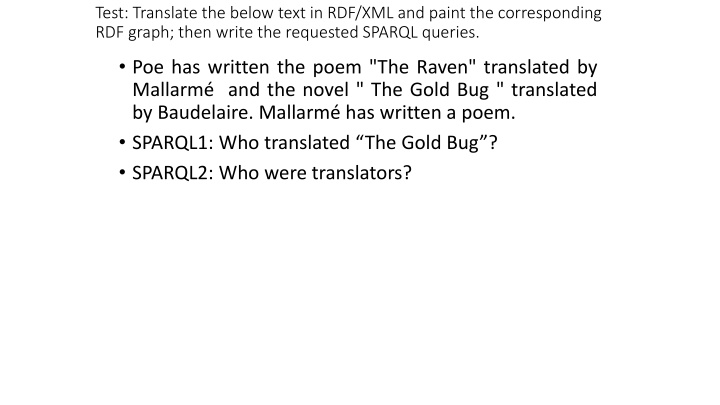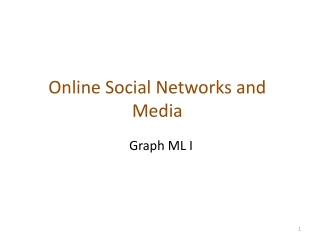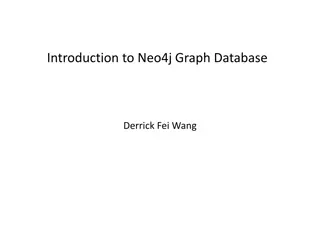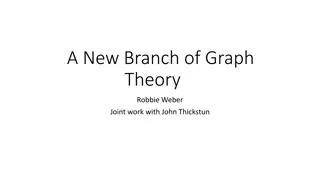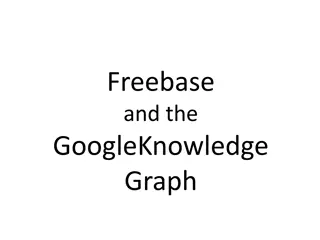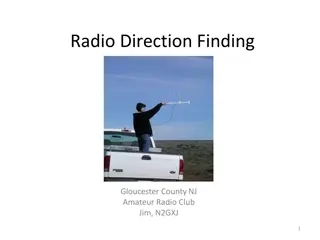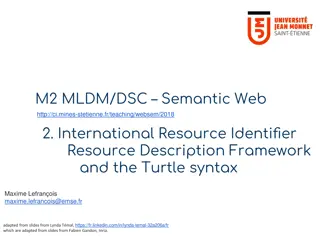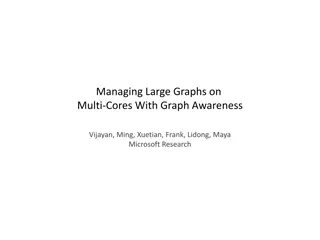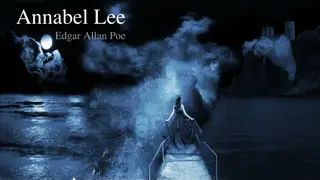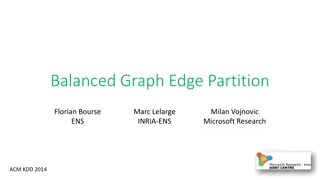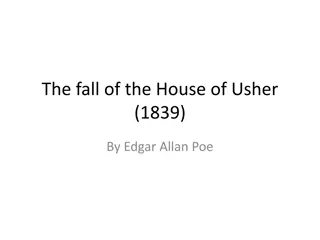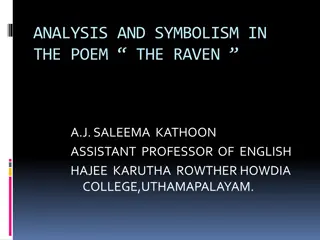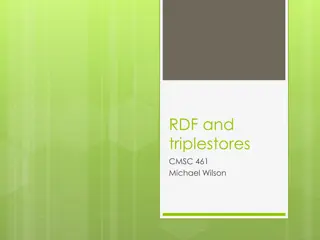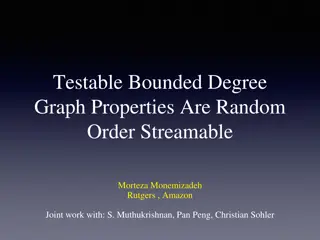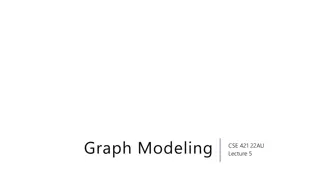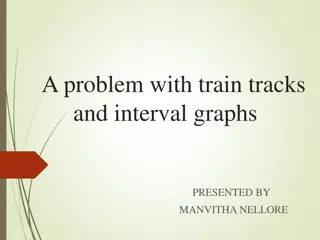RDF Graph Creation with Poe's Works
Learn how to create an RDF graph depicting the works of Poe, Mallarme, and Baudelaire. Explore how "The Raven" and "The Gold Bug" are translated by Mallarme and Baudelaire. Discover SPARQL queries for translators and more using Jena RDF API.
Download Presentation

Please find below an Image/Link to download the presentation.
The content on the website is provided AS IS for your information and personal use only. It may not be sold, licensed, or shared on other websites without obtaining consent from the author.If you encounter any issues during the download, it is possible that the publisher has removed the file from their server.
You are allowed to download the files provided on this website for personal or commercial use, subject to the condition that they are used lawfully. All files are the property of their respective owners.
The content on the website is provided AS IS for your information and personal use only. It may not be sold, licensed, or shared on other websites without obtaining consent from the author.
E N D
Presentation Transcript
Test: Translate the below text in RDF/XML and paint the corresponding RDF graph; then write the requested SPARQL queries. Poe has written the poem "The Raven" translated by Mallarm and the novel " The Gold Bug " translated by Baudelaire. Mallarm has written a poem. SPARQL1: Who translated The Gold Bug ? SPARQL2: Who were translators?
<?xml version="1.0" encoding="UTF-8"?> <rdf:RDF xmlns:rdf="http://www.w3.org/1999/02/22-rdf-syntax-ns#" xmlns:f="http://example.org#" xmlns:rdfs="http://www.w3.org/2000/01/rdf-schema#" xmlns:xsd="http://www.w3.org/2000/01/rdf-schema#"> <rdf:Description rdf:ID="Poe"> <f:name>Poe</f:name> <f:write rdf:resource="#Raven"/> <f:write rdf:resource="#TheGoldBug"/> </rdf:Description> <rdf:Description rdf:ID="Raven"> <f:name>Raven</f:name> <f:type>poem</f:type> <f:translatedby rdf:resource="#Mallarme"/> </rdf:Description> <rdf:Description rdf:ID="TheGoldBug"> <f:name>TheGoldBug</f:name> <f:type>novel</f:type> <f:translatedby rdf:resource="#Baudelaire"/> </rdf:Description> <rdf:Description rdf:ID="Mallarme"> <f:name>Mallarme</f:name> <f:write> <rdf:Description> <f:type>poem</f:type> </rdf:Description> </f:write>
Use http://www.w3.org/RDF/Validator/ to obtain the below graph: PREFIX f:<http://example.org#> SELECT ?n WHERE { } ?x f:translatedby ?y. ?y f:name ?n. ?x f:name "TheGoldBug" PREFIX f:<http://example.org#> SELECT ?n WHERE { } ?x f:translatedby ?y. ?y f:name ?n
Useful resources jena.apache.org/download/index.cgi (JENA code) https://jena.apache.org/tutorials/rdf_api.html (JENA tutorial) https://www.slideshare.net/rajighawi/java-and-sparql (SPARQL in Java)
Containers bag, alt, seq
Using SPARQL in Java import com.hp.hpl.jena.rdf.model.*; import com.hp.hpl.jena.query.*; String uri = "http://example.org/"; Model model = ModelFactory.createDefaultModel(); //the JENA RDF model Resource a = model.createResource(uri + John"); Resource b = model.createResource(uri + "Mary"); Property hasFriend = model.createProperty(uri + hasFriend"); a.addProperty(hasFriend, b); String queryString =" PREFIX f:< http://example.org/> \n" + " SELECT DISTINCT ?x \n" + " WHERE {?x f:hasFriend ?y} \n"; Query query = QueryFactory.create(queryString) ; QueryExecution qexec = QueryExecutionFactory.create(query, model); ResultSet results = qexec.execSelect() ;
Triplestores A triplestore or RDF store is a purpose-built database for the storage and retrieval of triples through SPARQL queries. Some examples of triplestores are: AllegroGraph Stardog GraphDB by Ontotext SPARQL 1.1 Update brings operations for updating, creating, and removing RDF graphs in a triplestore: https://www.w3.org/TR/sparql11-update/
Applications Recommender systems - How social and semantic technologies can sustain employability through knowledge development and positive behavioral changes https://www.sciencedirect.com/science/article/pii/S0747563217300250 Evaluation of open questions - Semantic Formative E-Assessment for Project Management Professionals https://ieeexplore.ieee.org/abstract/document/7275219 Curriculum modelling and aligning - Ontologies-Facilitators for Curriculum Design in Centers of Excellence for Engineering Education https://search.proquest.com/openview/a209c455a73c66a991b91465da1 cb4f9/1?pq-origsite=gscholar&cbl=1876338
Models https://www.dropbox.com/sh/2wy4epz1cgmtupw/AACKAR_NwKqc6e N8C_rdJJR1a?dl=0 https://mariaiulianadascalu.files.wordpress.com/2019/10/carteseweb _printech.pdf
